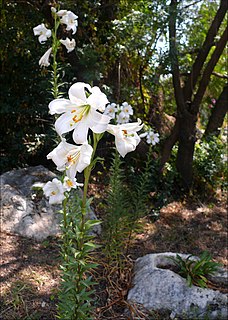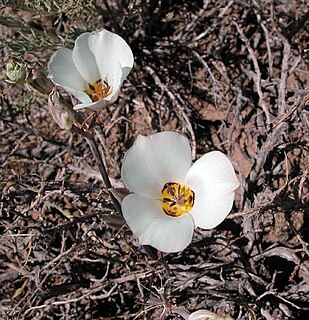
Lilium is a genus of herbaceous flowering plants growing from bulbs, all with large prominent flowers. They are the true lilies. Lilies are a group of flowering plants which are important in culture and literature in much of the world. Most species are native to the northern hemisphere and their range is temperate climates and extends into the subtropics. Many other plants have "lily" in their common names, but do not belong to the same genus and are therefore not true lilies.

Lilium bulbiferum, common names orange lily, fire lily,Jimmy's Bane and tiger lily, is a herbaceous European lily with underground bulbs, belonging to the Liliaceae.

Lilium humboldtii, or Humboldt's lily, is a species of lily native to the US state of California and the Mexican state of Baja California. It is named after naturalist and explorer Alexander von Humboldt. It is native to the South High Cascade Range, High Sierra Nevada, south Outer South Coast Ranges, and the Santa Monica Mountains and others in Southern California, growing at elevations from 600 metres (2,000 ft) to 1,200 metres (3,900 ft).

Lilium candidum, the Madonna lily, or white lily is a plant in the true lily family. It is native to the Balkans and Middle East, and naturalized in other parts of Europe, including France, Italy, and Ukraine, and in North Africa, the Canary Islands, Mexico, and other regions. It has been cultivated since antiquity, for at least 3,000 years, and has great symbolic value since then for many cultures. It is susceptible to several virus diseases common to lilies, and especially to Botrytis fungus. One technique to avoid problems with viruses is to grow plants from seed instead of bulblets.

Lilium longiflorum, often called the Easter lily, is a plant endemic to both Taiwan and Ryukyu Islands (Japan). Lilium formosanum, a closely related species from Taiwan, has been treated as a variety of Easter lily in the past. It is a stem rooting lily, growing up to 1 m high. It bears a number of trumpet shaped, white, fragrant, and outward facing flowers.

Jasminocereus is a genus of cacti with only one species, Jasminocereus thouarsii, endemic to the Galápagos Islands, territorially a part of Ecuador. In English it is often called the candelabra cactus. At maturity it has a branched, treelike habit, and may be up to 7 m (23 ft) tall. The stems are made up of individual sections with constrictions between them. Its creamy white to greenish flowers open at night and are followed by greenish to reddish fruits.

Lilium martagon, the martagon lily or Turk's cap lily, is a Eurasian species of lily. It has a widespread native region extending from Portugal east through Europe and Asia as far east as Mongolia.

Lilium speciosum is an East Asian species of plants in the lily family. It is native to southern Japan and southern China, where it can be found at elevations of 600–900 metres (2,000–3,000 ft). It is sometimes called the Japanese lily though there are other species with this common name.

Lilium nepalense, the lily of Nepal, is an Asian plant species in the lily family. It is native to the Himalayas and nearby regions: northern Thailand, northern Myanmar, Assam, Bhutan, Sikkim, Nepal, Uttarakhand, Tibet, and Yunnan. It can be found growing on wet forest borders at 1,200 to 3,000 m.

Lilium maculatum is a plant in the lily family native to Japan.

Calochortus bruneaunis is a species of flowering plant in the lily family, and is known by the common name Bruneau mariposa lily.

Lilium wallichianum is an Asian species of bulbous plants in the lily family native to the Indian Subcontinent and to Myanmar. It is native to India, as well as Nepal, Bhutan, and Myanmar.

Lilium monadelphum is a bulbous plant native to Crimea and to North and South Caucasus.

Lilium medeoloides is an East Asian herb in the lily family. It is native to Zhejiang Province in China, Jeju-do in Korea, and eastern Russia, where it grows in forests and on grassy and rocky subalpine areas.

Roscoea capitata is a perennial herbaceous plant native to the Himalayas, being found in Nepal. Most members of the ginger family (Zingiberaceae), to which it belongs, are tropical, but R. capitata, like other species of Roscoea, grows in much colder mountainous regions.

Lilium concolor is a species of flowering plant in the lily family which occurs naturally in China, Japan, Korea and Russia. Its relationship with other species is not clear, although it has some similarities to Lilium pumilum.
Iris subg. Nepalensis is one subgenus of Iris, also known as 'Himalayan irises'. It was formerly genus Junopsis.

Cardiocrinum cordatum, also known as Turep in the Ainu Languages, is a Northeast Asian species of plants in the lily family. It is native to Japan and to certain Russian islands in the Sea of Okhotsk.

Lilium polyphyllum is a species of lily endemic to montane environments in central Asia.

Ilex umbellulata is an evergreen tree species related to holly, generally four to fifteen metres in height. It is found in Southeast Asia. This tree is most often found growing in forests.






















